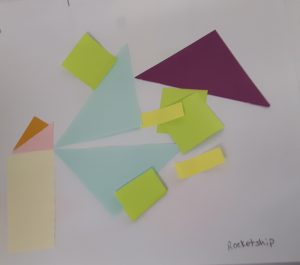In this lesson I began by reading Three Pigs, One Wolf, and Seven Magic Shapes by Grace Maccarone. Although the book is based on tangrams I chose to include it because of the variety of objects the shapes were used to create.

Many students made variations of houses using the shapes. This student used a parallelogram as a sidewalk.
During the reading I chose to exclude some of the sections since they were repetitive and not important to my lesson. The book was well received as I had expected – the students have read several varieties of the three pigs and the wolf making it familiar to them.

Some students labelled their pictures and drew additional features.
After we read the book we reviewed the representations the shapes were used for and brainstormed our own ideas. The students were then sent on their own to use shapes to create their own representations.
Prior to the lesson I cut post-it notes into the shapes needed which allowed students to change their representations as they went.

Some students made something other than the brainstormed ideas and the representations in the book read prior to the lesson. This student made a rocketship, other ideas included trees, trains, a dog, and suns.
Although most of the products were houses the students were engaged in the process of making their pictures and many placed a personal spin on it.
During the activity a few students working at one table stated that many people were making houses. When I inquired as to why they thought that, one student said it was because houses were easy and everyone wanted to do something easy. Given the shapes provided (squares, rectangles, triangles, and parallelograms), a house could easily be the first idea to come to a students mind however, I found it interesting that despite the large amount of houses and the higher number of students making houses adjacent to each other, that no two houses were the same. This result emphasized that even when given the same starting point each student used their personal creativity in the assignment.
